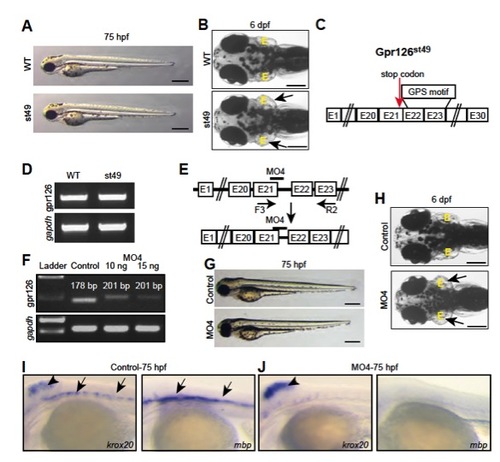
Inhibition of the 7TM domain of zebrafish Gpr126 does not disrupt heart morphogenesis. (A) No pericardial edema is observed at 75 h postfertilization (hpf) in gpr126st49 zebrafish mutant embryos. (Scale bar: 400 μm.) (B) Dorsal view of a WT and a gpr126st49 mutant larva at 6 d postfertilization (dpf). gpr126st49 mutant larva showing enlarged ears (arrows). (Scale bar: 200 μm.) (C) Schematic depiction of zebrafish gpr126st49 mutant mRNA. The mutation introduces a premature stop codon before the GPS motif (red arrow). (D) RT-PCR analysis showing that gpr126 mRNA transcripts could be detected in gpr126st49 mutants. gapdh was used as loading control. (E) Schematic depiction of zebrafish prespliced gpr126 mRNA. Exons are represented by boxes, and introns are represented by lines. Bar represents the MO4 binding site. Arrows below the respective Exons indicate primer binding sites; these are used to analyze the fate of prespliced gpr126 mRNA after MO4 injection. (F) RT-PCR analysis of mRNAs from WT and MO4-injected 3-dpf zebrafish embryos using primers as indicated in E. gapdh was used as loading control. MO4 injection resulted in partial intron insertion. (G) MO4 injection did not cause pericardial edema at 75 hpf. (Scale bar: 400 μm.) (H) Dorsal view of a phenol red-injected WT larva and a MO4-injected larva at 6 dpf. MO4-injected larva showing enlarged ears (arrows). (Scale bar: 200 μm.) (I and J) Whole-mount in situ hybridization demonstrating krox20/egr2 [hindbrain, arrowhead; posterior lateral line nerve (PLLn) Schwann cells, arrows] and mbp (PLLn Schwann cells, arrows) expression at 75 hpf. MO4 morphants, which express NTFΔGPS but not CTF, exhibit normal expression of krox20/egr2 in the hindbrain (arrowhead), but both krox20/egr2 and mbp expression are down-regulated in the PLLn at 75 hpf. E, ear.
|

